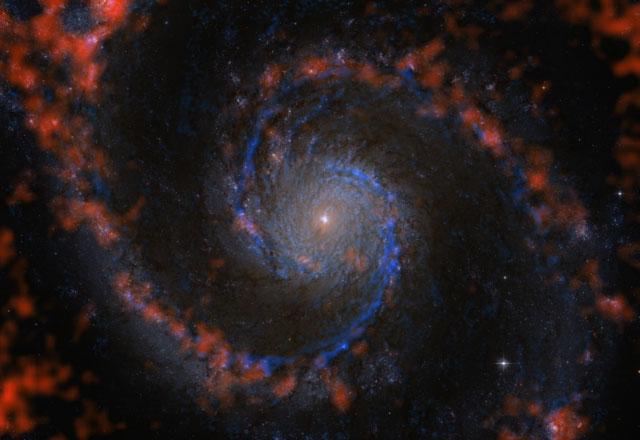A multi-year study of the Whirlpool galaxy (M51) has shaken up astronomers’ views of the properties of giant molecular clouds. The new study, which mapped 1,500 such clouds, shows that, instead, they are embedded in a kind of fog of molecular hydrogen much more dense than anyone expected, which permeates the whole of the galactic disc. Pressure exerted by this fog is crucial in determining whether or not new stars will form within the clouds. The study, led by Eva Schinnerer from the Max Planck Institute for Astronomy, made extensive use of the millimeter telescopes of IRAM, the Institut de Radioastronomie Millimétrique.
Most of a galaxy’s stars are born within giant molecular clouds - accumulations of hydrogen molecules with total masses between a thousand and several million times that of our Sun. As a region within such a cloud collapses under its own gravity, it contracts until pressure and temperature are high enough for nuclear fusion to set in: a new star is born.
Now, a new study challenges astronomers’ traditional views about these stellar birthplaces. Study leader Eva Schinnerer (Max Planck Institute for Astronomy) explains: “Over the past four years, we have created the most complete map yet of giant molecular clouds in another spiral galaxy similar to our own Milky Way, reconstructing the amounts of hydrogen molecules and correlating them with the presence of new or older stars. The picture that is emerging is quite different from what astronomers thought these clouds should be like.” The survey, known as PAWS, targeted the Whirlpool galaxy, also known as M51, at a distance of about 23 million light-years in the constellation Canes Venatici (“Hunting dogs”).

Molecular hydrogen in the Whirlpool Galaxy M51. The blueish features show the distribution of hydrogen molecules in M51, the raw material for forming new stars. The PAWS team has used this data to create a catalogue of more then 1,500 molecular clouds. The reddish structures show the distribution of hydrogen atoms. The background is a color image of M51 by the Hubble Space Telescope. Credit: PAWS team/IRAM/NASA HST/T. A. Rector (University of Alaska Anchorage)
For a little more insight into the project see this:http://www.iram-institute.org/EN/news-astronomers/2013/85.html

